Texas Railroad History - Tower 19 - Dallas
Crossing of the Gulf, Colorado & Santa Fe Railway
and the Missouri, Kansas & Texas Railway

Above: From the rear platform
of his business car, railroad executive John W. Barriger III took this photo
facing northwest toward downtown Dallas sometime between the mid 1930s and the
early 1940s. Barriger's train is headed south on tracks of the
Missouri - Kansas - Texas (MKT) Railroad. His business car has just crossed Gulf, Colorado & Santa Fe
(GC&SF)
Railway tracks
that angled northeast across Dallas south of downtown. Tower 19 -- here seen trackside to
the right -- sat in the north quadrant of this X-pattern crossing. The tower
Barriger saw was not the first iteration of Tower 19. Railroad Commission of Texas
(RCT) documentation archived
at DeGolyer Library, Southern Methodist University, includes a map dated
November 6, 1908 showing Tower 19 in the south quadrant of the diamond,
presumably its original location upon commissioning in July, 1903. Another map dated November 19, 1921 shows the tower in the north quadrant.
Tower 19 was a "Santa Fe tower", i.e. designed, built and staffed by GC&SF
personnel, although capital and recurring expenses were shared with MKT and
eventually with other railroads. It resembles other Santa Fe towers for which
photos exist, e.g. Tower 57, which opened about 1.5
miles north of Tower 19 in November, 1904. In the early 1990s, a detailed study
conducted by the Historic American Building Survey (HABS) as part of the
Historic American Engineering Record (HAER) reported 1924 as the date of Tower
19's construction, but the source for that date has not been determined. If it
is accurate, then the most likely scenario is that sometime between 1908 and
1915, the GC&SF moved the original tower diagonally across the diamond.
Relocating the tower out of the south quadrant would clear real estate for new
Union Terminal Co. tracks that would connect to the Santa Fe tracks at Tower 19.
Union Terminal was building the new Dallas Union Station, which opened less than
two miles north of Tower 19 in October, 1916. Union Terminal tracks are shown
near Tower 19 on a 1915 MKT track chart but they do not appear in Barriger's
photo, likely replaced in 1920 by a second main line parallel to MKT's tracks.
After relocation of the original tower in 1921 (or earlier), a new tower was
built in 1924, also on the north side of the diamond, mounted on the large
concrete pedestal visible in Barriger's photo.
The other possibility is
that the 1924 construction date reported by HABS is simply wrong, and a new
tower had been built in the north quadrant by 1921 and perhaps by 1916.
Unfortunately, the MKT track chart from 1915 does not show any of the three towers
(10, 19 and 57) that could have been marked, and oddly, no mention of any Tower
19 reconstruction has been noted thus far in reviews of the files at DeGolyer
Library. If the north quadrant tower on the 1921 map was a new tower, it was
constructed sometime after 1908, a maximum span of thirteen years. This would
tend to make it less likely that Tower 19 was rebuilt again in 1924. However,
the massive 1922 flood on the Trinity (before the levees were built) might have
justified a 1924 rebuild even if the 1921 tower was a relatively new structure.
Regardless, the tower that Barriger photographed was the final version of Tower
19 and it is preserved at the
Museum of the American Railroad in Frisco, Texas (photo
below, from Google Street
View, September, 2018.) It sat on a concrete pedestal for flood protection -- it
was only a half mile from the main channel of the Trinity River, well within the
flood plain. The original tower had likely suffered substantial damage from the massive flood of May, 1908
(Tower 57 was described as "under water"), which surely influenced the
decision-making over Tower 19's relocation and/or rebuild. The pedestal has been recreated at the
Museum to elevate
the tower to its operational height. The original 1903 tower might have been
elevated to some extent, just for drainage purposes -- note the low lying area
diagonally across from the tower in Barriger's photo -- but it is doubtful that
it was
enough to mitigate damage from the 1908 flood.

By the early 1870s, Dallas had become a two-railroad
city. The east/west Texas & Pacific (T&P) crossed the north/south Houston &
Texas Central (H&TC) at the east end of downtown, and investors had begun to look at building rails in additional directions.
Cleburne, about fifty miles southwest, was viewed as a prime opportunity. It
had become the seat
of Johnson County a few years earlier and was experiencing rapid population growth.
After a chartered narrow-gauge railroad had twice failed to attract enough investment
to initiate construction, a new charter was issued
in September, 1880 for a standard
gauge rail line to Cleburne to be known as the
Chicago, Texas & Mexican Central Railway Co. (CT&MC). The CT&MC construction
began at Dallas in 1881, the goal being a connection at Cleburne with the Gulf, Colorado
& Santa Fe (GC&SF) Railway. The GC&SF tracks had reached Cleburne only two
months earlier as part of a main line being built from Temple to
Fort Worth. When area newspapers celebrated the
first CT&MC train from Dallas in January, 1882, the railroad was already facing
bankruptcy. Its financial condition quickly became public as contractors gave
stories to the newspapers about the CT&MC's failure to pay its bills. Despite negative cash flow and
significant debt, its rail line from Cleburne to Dallas was valuable, as was its
right to build farther northeast from Dallas to Paris,
a feature incorporated into the charter ostensibly to support building north
toward Chicago. Rumors began to spread
that the GC&SF would rescue the CT&MC simply to acquire the tracks to Dallas. The Fort Worth Daily Democrat of
March 3, 1882 reported "...that the company proposes to clear
the road of debt, and that negotiations on that basis are going on with the
Gulf, Colorado and Santa Fe for the Chicago, Texas and Mexican Central."
The GC&SF proceeded to buy the CT&MC on August 1, 1882 and assume its debt.
That same day, August 1, 1882, rail baron Jay Gould bought the Galveston,
Houston & Henderson (GH&H) Railroad. The GH&H owned a bridge from
Galveston Island to the mainland at
Virginia Point, and tracks from there to
Houston. It was a small railroad, but its access
to Galveston -- Texas' largest city -- was important because Gould wanted to
export Midwest agricultural and industrial products through the Port of
Galveston. Gould had been assembling a collection of
lines from the Midwest to
Houston under his Missouri Pacific (MP)
Railroad (where he had a large ownership position.) His objective was for MP to control the entire haul
from St. Louis and Kansas City to Galveston; the GH&H was the
final piece of the puzzle.
Earlier, Gould had initiated takeovers of various
Texas
railroads to provide the intermediate routes. One of these was the Missouri, Kansas & Texas (MK&T, "Katy")
Railway, which had built south from Missouri and Kansas through Indian Territory
and completed a bridge over the Red River into Denison in late
1872. (By the time of Barriger's photo above, the railroad's name had changed to
the Missouri - Kansas - Texas Railway as a result of a corporate reorganization
during its emergence from bankruptcy in 1923 -- but everyone just called it the
Katy.) Gould immediately saw the value of the bridge at Denison, so in 1873, he initiated a long term plan to take control of the Katy by getting
his henchmen hired into Katy's executive management. Though it took six years,
in
December, 1879 they had accumulated sufficient power to orchestrate Gould's election
as President of the
Katy.
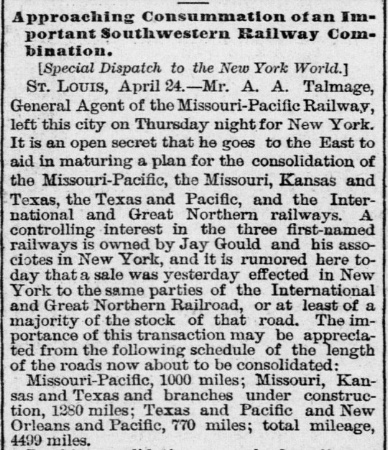 |
Gould was the Katy's President, but he had little ownership in the
company -- the Katy's stock was so diluted that there were few large
blocks of stock available for private sale. To
bolster his control, Gould leased the Katy in December, 1880 to
MP. He then initiated an expansion deep into Texas with new construction and
takeovers of existing railroads. MP was the public face of the Texas
construction but the work was legally conducted under the Katy name; MP did not have a charter to build railroads in Texas.
One of the new Katy lines was from Greenville to
Mineola, to which an International & Great
Northern (I&GN) branch line had been built years earlier. The Katy
already had a Denison - Greenville line, and Gould had his sights on the I&GN; its branch led to a main line
route to Houston, thus facilitating Denison - Houston service via
Mineola.
Gould next pursued the T&P. Its construction from
Texarkana to El Paso had stopped in
Ft. Worth due to financial difficulties. Gould offered to build the
remainder of the line in exchange for T&P stocks and bonds conveyed to
him on a "per-mile" basis. As he built westward, he soon accumulated
a controlling interest, ratified by T&P shareholders in April, 1881. Gould
promptly leased the T&P to MP. He then
turned to the I&GN, the largest railroad in Texas. Via Longview, the T&P and
the I&GN would
provide a Texarkana to Houston haul, and MP already controlled tracks
from St. Louis to Texarkana. Via Denison and Mineola, the Katy and I&GN would
have rails from Missouri and Kansas all the way to Houston, to which the Katy
was also building via Ft. Worth
and Waco. Gould was able to pressure I&GN
management to agree to a stock swap for Katy securities in June, 1881,
giving the Katy ownership of the I&GN.
Left: Even before the
I&GN deal was sealed, the Galveston
Daily News of April 30, 1881 carried this dispatch from St.
Louis speculating on a consolidation plan for Gould's Texas railroads
into MP.
Gould's
Texas railroads remained legally separate despite being effectively
controlled by MP.
Gould needed to maintain them as such because they had
charter authorizations to build and operate rail lines in Texas,
something MP did not have. MP would have no hope of getting its own
Texas charter passed into law -- the Legislature would face too much
public opposition stirred up by rival Texas railroads. As a result of
accounting and operating policies tilted heavily toward MP, its
stockholders (particularly Gould) would reap the benefits of the
combined enterprise, to the substantial detriment of the stockholders of
the Katy. |
By the fall of 1882, the GC&SF was rightfully alarmed
by Gould's moves. Unless it could find a partner to
stimulate traffic with out-of-state markets, it was destined to become
subservient to the bigger railroads in Texas, of which the Gould amalgamation was
the largest. In 1886, the GC&SF agreed to be acquired by the Atchison, Topeka &
Santa Fe (AT&SF) Railway, a larger, high plains and southwestern railroad
ranging from Kansas to California. There had been rumors that the GC&SF's goal
in acquiring the CT&MC in 1882 was to "out-flank" Gould by building a line to
Paris to meet the St. Louis - San Francisco ("Frisco") Railroad which was
building south from Missouri. A connection at Paris would produce a faster route
from St. Louis to most Texas destinations compared to Gould's routes via
Texarkana or Denison. The line to Paris was built by the GC&SF in 1886 as part of
its acquisition by the AT&SF.
In November, 1886, a new Texas Attorney General, James S.
Hogg, was elected on a campaign to go after the railroads for various
infractions of state law and violations of their charters. Hogg wasted no time
in filing lawsuits, particularly against the I&GN and the Katy. When all of the legal dust
settled several years later, Gould was no longer President of the Katy -- he'd
been fired by its stockholders, MP's lease of the Katy had been revoked, and the
Katy's expansion into Texas had been declared unlawful by the Texas
Supreme Court. State law in 1870 had granted the Katy permission to use
its Kansas charter as the basis for crossing into Denison over its
planned Red River bridge, but under Gould's control, the Katy had begun
to expand southward toward Houston (which Gould argued was permissible
since building to "the Rio Grande" was mentioned in the Kansas charter.)
As the Katy had neither
a Texas headquarters (a state law requirement) nor a Texas charter, the court ruled the expansion illegal. To clean up
the Katy's mess in the aftermath of the litigation, a new Texas charter for
the Katy was filed on October 28, 1891
and approved by the Legislature establishing the Missouri, Kansas & Texas
Railway Co. of Texas, to be headquartered at Denison as a wholly-owned
subsidiary of the parent Katy corporation. The Katy was forced to sell the I&GN
back to Gould; the Legislature was simply unwilling to grant the charter if the
Katy owned the I&GN.
Under Gould, the Katy had frequently arranged
for independent investor groups to charter and build branch lines that
would later be acquired and merged into the Katy. One such line was the
Dallas & Waco Railroad, sponsored by the Katy for the purpose of
building between Dallas and Hillsboro. The Katy already served Hillsboro
on its main line south from Ft. Worth, and the Katy served Dallas with a
line from Denison via Greenville. It also had a branch to Dallas from
Denton, a town on the Whitesboro - Ft. Worth joint line shared with the
T&P. Dallas was becoming too important to be a dead end for the Katy,
hence the decision was made to build south from Dallas to reach the main
line out of Ft. Worth at Hillsboro. The overall goal was to continue
pushing south and east toward Houston. Despite the Katy's on-going
litigation in various courts, the Dallas - Hillsboro line was completed
in 1890 and its operations were absorbed into the Katy in 1891 under the
new charter. The Dallas - Hillsboro line crossed the Santa Fe tracks
south of downtown
Dallas, the future site of Tower 19.
Right: The Frisco's line to Paris in 1888
enabled Santa Fe to counter Gould's domination of Midwest
traffic. The Katy returned to independence with a Texas charter in 1891,
but Gould maintained control of the I&GN and the T&P. Jay Gould died in late 1892 and was
succeeded by his son George as President of both railroads. |
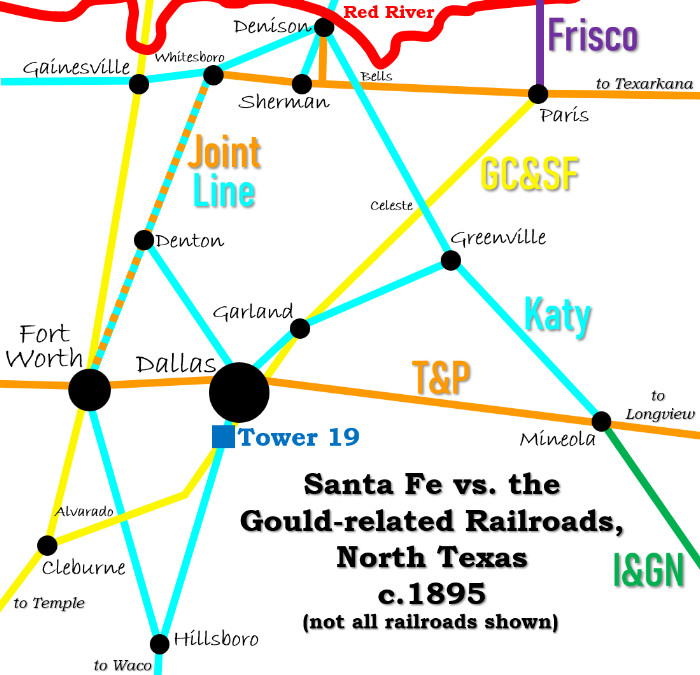 |
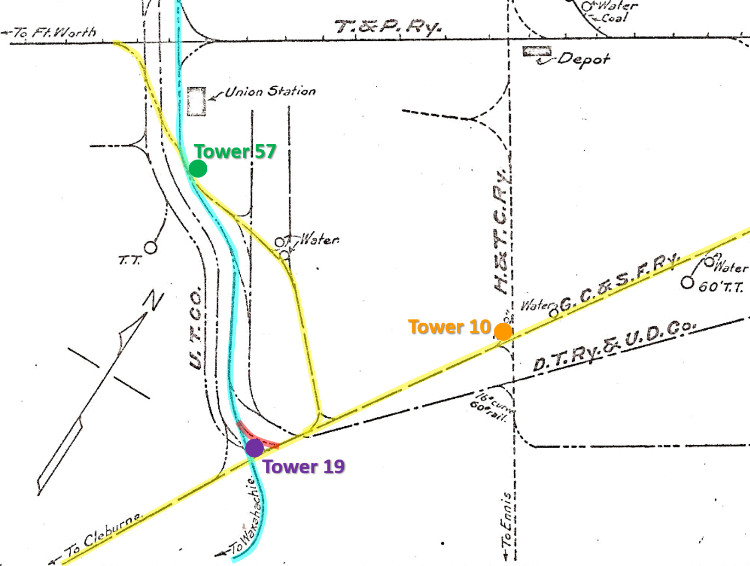 |
Left: This
1915 track chart from the Office of the Chief Engineer of the
Missouri, Kansas & Texas Railway Co. of Texas (the office was located
in Dallas) is highlighted to show three towers and the path of the Katy
(blue) and Santa Fe (yellow) tracks south of downtown. According to RCT
records, Tower 19 was
authorized to begin operations on July 27, 1903. It housed an electrical
interlocking plant with sixteen functions built by the Taylor Signal Co.
The specific function allocation has not been found, but it was most
likely a home signal, distant signal and derail in each of the four
directions, plus a switch and signal at each end of an exchange track.
Presumably the exchange track on this 1915 map (highlighted in red)
dated back to 1903. By the time this map was drawn, the plant at Tower
19 had increased to twenty functions, probably due to tracks of
two railroads that appear on the map: the Dallas Terminal Railway and
Union Depot Co. (DTR&UD, owned by the St. Louis Southwestern Railway --
its "Union Depot" never caught on with other railroads), and the Union
Terminal Co., which had been established by eight railroads to build
Union Station and associated switching tracks. Both would eventually be
added to the list of railroads that shared Tower 19's expenses.
Information released by RCT in 1916 confirms that Santa Fe had the
staffing responsibility for Tower 19. This was no surprise; Tower 19 was
a "Santa Fe tower" in all respects.
Tower 10 sat
less than a mile northeast of Tower 19 at Santa Fe's crossing of the
Houston & Texas Central (H&TC) Railway, a Southern Pacific
(SP) subsidiary. Tower 10 was a Santa Fe tower, as was
Tower 57 located 1.5 miles north of Tower
19. Tower 57 controlled the west end of downtown along the east bank of the Trinity
River near Union Station, which was still under construction in 1915.
Photos show Tower 57 to be virtually identical in architecture to Tower
19. When Union Station opened in October, 1916, Tower 57 was retired, replaced by
Towers 106 and 107, north and south,
respectively, of Union Station. (track chart, Ed Chambers Collection) |
The T&P tracks through downtown were relegated to
secondary status beginning in late 1920 when its trains began routing
south of downtown on the Katy's tracks and the
initial segment of the Dallas Belt Line to T&P Jct. At
least one additional track from Union Station to Tower 19 had
been built prior to 1915 (per the track chart), and in late 1920, a main line
parallel to the Katy was extended across the Santa Fe line all the way to
Metzger near Belt Jct. Previously, T&P trains would have been
a rare sight at Tower 19, but now they were a frequent occurrence, multiple
times each day. The additional tracks in the immediate vicinity of
Tower 19 belonging to the Union Terminal Co. and the DTR&UD also contributed
to increased workload in the tower. Both railroads eventually (DTR&UD in 1923, and Union Terminal Co.
in 1926) began sharing Tower 19's expenses. Between December 31, 1922
and December 31, 1923, the function count at Tower 19 increased 350%
from 20 functions to 90 functions, implying either a new
interlocking plant had been installed to increase capacity, or Tower 19 had
begun to control other interlockers remotely. It is possible that the asserted
1924 rebuild of Tower 19
could have been nearing completion in late 1923, and if so, Santa Fe would have
been able to incorporate the larger interlocking plant needed to support 90
functions. As it seems rather obvious to expand the tower's
physical capacity before -- or at least
coincident with -- its functional expansion, perhaps this is evidence that the
"1924 rebuild" was actually conducted earlier, sufficiently in time for
integration of the dramatic function increase reported operational by RCT at the
end of 1923. The second phase of the Dallas Belt Line was already in progress,
and it had predictable consequences for Tower 10. Santa Fe knew there would be
an eventual consolidation, supplying yet another justification for a larger
tower. Whenever it was built ... how this new tower building differed from
its predecessor is a subject for further research; the original design of Tower
19 remains undetermined.
With completion of the Dallas Belt Line
in 1926, SP freight trains began routing east of downtown through T&P Jct.,
reducing the traffic past Tower 10 as the original H&TC main line became
relegated to industry service. Ten years earlier, SP passenger trains had
started routing to Union Station using Katy and Union
Terminal tracks; this had also reduced Tower 10's traffic. On July 23, 1932, Santa Fe submitted a
proposal to combine Tower 10's functions into Tower 19. Two months later,
the RCT engineering staff recommended approval of the plan and it was granted by the
Commissioners. A new General Railway Signal Co. interlocking plant was
installed and the interlocker functions for Tower 10 were incorporated into
Tower 19, effective March 6, 1933.
RCT's Tower 19 documentation has references to "Interlocker10-19", perhaps the chosen
nomenclature for the new interlocking plant.
Whether the relocation of
Tower 10's functions into Tower 19 also included remote control of
Tower 22 has
not been determined.
Tower 22 was Santa Fe's crossing of the
original T&P main line east of downtown, about a quarter mile east of Santa
Fe's yard. By 1921, it would have been seeing substantially reduced traffic
because it was bypassed by the reroute of T&P traffic south of downtown. Tower
22 was staffed by T&P, and the date of its final demise is unknown. However, a
1961 RCT document references "Interlockers 10 and 22", suggesting that their
operational control may have been combined at some point, even if they remained
separate interlocking plants. Folding Tower 22's operations into Tower 10 would
have made sense c.1921. Remote control of the
Tower 22 interlocker was eventually assigned to Tower 19, but when this occurred
is undetermined.
|
Right: The operator's
desk inside Tower 19 incorporated a track diagram at the top of the
console. As technology improved, functions that were once controlled
using the large handles on the
interlocking machine could be reduced in size and controlled by small
electrical switches. By 1984, Tower 19's functions were controlled by levers on the interlocking
machine in combination with electrical switches. By pulling or pushing the levers, the tower operator could align rail
switches and signals for a specific train movement. Once aligned, a
conflicting movement could not be aligned until after passage of the
first train. (Bob Courtney photo, 1984) |
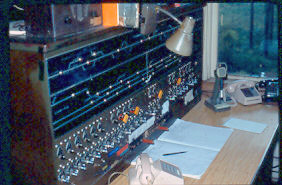 |
On February 13, 1928, automatic block signals installed
by SP began operating between Belt Jct. and the Belt Line's intersection with
the Katy tracks at Forest Ave., 0.2 miles south of Tower 19. A year earlier, SP
had begun leasing its Texas railroads, including the H&TC, to the Texas & New
Orleans (T&NO) Railroad, designated to be SP's primary operating company for
Texas and Louisiana. In 1934, these leases became corporate mergers and the H&TC
ceased to exist. T&NO was included among Tower 19's expense-sharing railroads
at some point, but it is not listed as such in RCT's final comprehensive interlocker
table published at the end of 1930. Documentation at DeGolyer
Library states that H&TC began sharing Tower 19's expenses in February, 1928,
when operation of the automatic block signals commenced, suggesting that
monitoring indicators and override controls for these signals were incorporated
into Tower 19.
On March
14, 1958, RCT issued a memo to Santa Fe authorizing removal of nine specific
derails that were manually controlled by Tower 19, presumably in response to a
request by the affected railroads. Application was then made to the Interstate
Commerce Commission (ICC) for permission to remove the derails. The proposal was
jointly opposed by four railroad employee unions for safety reasons. The ICC
responded with a September, 1958 ruling
that begins by noting that the application had been filed jointly by all five railroads that "owned" Tower 19, the Katy, Santa Fe, Union Terminal Co.,
DTR&UD and T&NO. The ICC granted permission for removal of six of the nine
derails, including the five that dated back to 1918. Those were at the
point of needing to be removed or replaced -- they could no longer be maintained
as parts were unavailable. The other four derails had been upgraded to newer
technology when various track adjustments were made as part of a City of Dallas
project for grade separation of city streets in the vicinity of the Tower 19 and
Tower 10 crossings, a project that commenced in September, 1948. One of these
newer derails was also authorized for removal. The ruling provides some interesting background statistics:
in the month of May, 1958, Tower 19 saw 568 passenger trains and 641 freight
trains on the Katy tracks, and 62 freight trains on the Santa Fe tracks (Santa
Fe passenger trains did not pass Tower 19.) There was also an average of 7.8
daily switching movements on Santa Fe's tracks past Tower 19, and a total of
4,271 switching movements on the other tracks during the month.
By the
mid 1960s, RCT had recognized that it no longer had much, if any, regulatory
control over Texas' railroads. The ICC was fully regulating interstate
railroads, and all railroads had to comply with Federal safety regulations which
included grade crossing safety. Every rail line in Texas was subject to ICC
jurisdiction since every track regularly saw (or could
see) trains moving in interstate
commerce. RCT had recognized that it had inadequate engineering resources to
stay abreast of the rapid advances in railroad signaling and communications
technology that had begun in the 1950s. Instead, RCT had changed the focus of
its staff toward regulation of Texas' oil industry which was also within its
purview. Oil industry regulation was strictly a state responsibility with little
Federal involvement. The three RCT Commissioners had to face the voters every
two years, and many of these voters owed their jobs directly or indirectly to
the oil industry, or were otherwise affected by oil company practices,
production levels, and leasing and royalty policies for land and mineral rights.
The Commissioners knew where the votes were, and it was not in railroad
regulation. The last document in the Tower 19 file at DeGolyer Library is a 1967
memo regarding track changes being made by SP associated with an industrial lead
near the Tower 10 crossing, which had long been under Tower 19 remote control.
In 1990, Santa Fe sold its
Dallas yard and its tracks south toward Midlothian to the Dallas Area Rapid Transit
(DART) system. DART planned to use a portion of this right-of-way for a light
rail line into southwest Dallas (which ultimately became the DART Red Line.) In 1991, the Southwest
Railroad Historical Society (SRHS) began efforts to acquire and preserve the tower. Even though DART
now owned the rail line, the tower was still in service. The original plan was
for Tower 19 to remain where it was until it was removed from service. However, Union Pacific
(which had acquired the Katy) needed additional time to make changes to support
removing Tower 19 from service. To prevent delaying construction
of the light rail line, Tower 19 had to be relocated. It was removed from its first
floor concrete foundation and shifted about 50 feet east. It rested
on movers beams, but had all necessary control functions re-connected
for service.
The tower was finally removed from operational service in the summer of 1993.
For more than two years, it remained near the crossing,
unused and unprotected except for boards over the windows, suffering vandalism
with most
of its copper wiring stripped out. Fortunately, most
of the damage was on the lower floor; the upper floor, including
the interlocking machine and track diagram, remained intact. In August, 1996, the
tower was moved
to the SRHS-sponsored Age of Steam Railroad Museum at Fair Park in Dallas and installed on a
concrete pedestal to reproduce its operational height. The move was documented
in the October, 1996 issue of Clearance Card, an SRHS
publication. In March, 2012, it was
relocated to the
Museum of the American Railroad in Frisco, Texas for permanent preservation and
restoration.

These Tower 19 photos are from the Historic
American Engineering Record (HAER), Library of Congress. They are identified as a component of
HAER "...documentation compiled after 1968", which unfortunately says
nothing about the actual date the photos were taken, which remains undetermined.
Above: The Santa Fe tracks ran
along the short side of the tower. Note the outline of clean boards that were added to fill in a lower
story window. The adjacent sheds were storage for track and tower maintenance
equipment. Below Left: The
long, front side of the tower had the staircase and faced the Katy tracks. A window
on the lower story to the right of the door (by the "19" placard) has been boarded up.
Below Right: On the back side of the tower, two large windows
on the lower story are boarded up. Preservation efforts at the Museum of the
American Railroad have restored all of these windows.


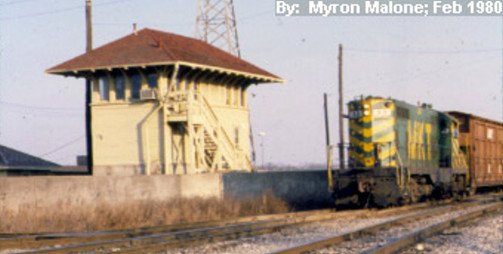 |
Left: MKT GP 94
passes Tower 19 heading to Dallas Union Station in February, 1980.
Right:
A Santa Fe caboose passes Tower 19 in September, 1982. Note that the front,
lower story window to the right of the door is intact.
(both photos by
Myron Malone) |
 |


Above Left: By September
1992, the diamond connecting the Santa Fe Dallas Yard to its line to Cleburne
had been removed. The sale of the Santa Fe property to DART and the associated
changes that would put Tower 19 out of service had begun. In the background, a
Kansas City Southern (KCS) train can be seen; KCS had acquired Santa Fe's tracks
as far as Farmersville on the Paris line, and it used the Santa Fe
yard as the
interchange point with other railroads in Dallas. (Myron Malone photo) Above Right: Tower
19 was
moved in August, 1996 to Fair Park and placed on a newly
poured concrete base to match the original height of the tower. (Hume Kading
photo)
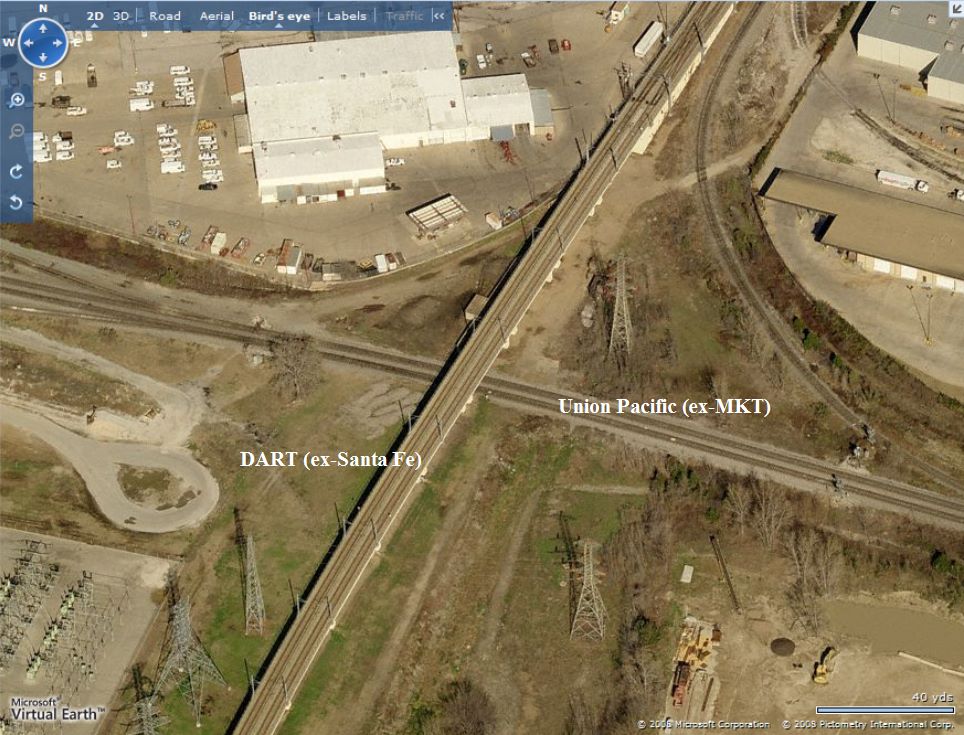 |
Left:
With the tower removed, DART constructed a grade-separated crossing for
its light rail line to south Dallas, passing over Union Pacific's ex-MKT
tracks. (Microsoft Virtual Earth c.2008)
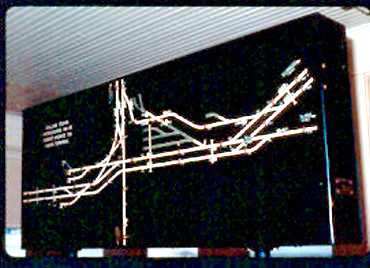
Above & Below: Track
diagrams located at Tower 19's interlocking control consoles had various
small lights to indicate the presence of trains. (Bob Courtney photos,
1984)
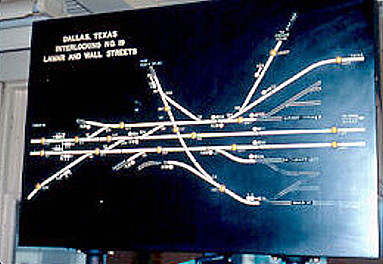 |
Tower 19 Drawings
from the Historic American Building Survey are here.















